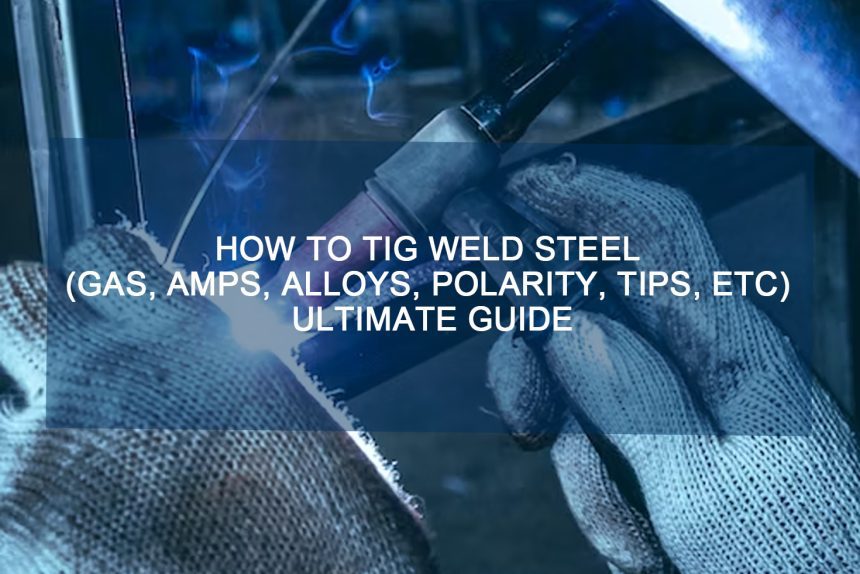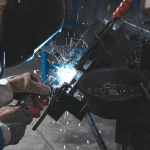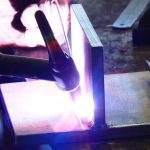TIG welding, also known as Tungsten Inert Gas welding, is a highly valuable method for joining metals, especially steel. This technique involves heating the metals using an arc created between the tungsten electrode and the base metal.
How to TIG Weld Steel
Welding Town
(Gas, Amps, Alloys, Polarity, Tips, etc)
Ultimate Guide
How to TIG Weld Hardened Steel?
Another crucial consideration when performing TIG welding on hardened steel is to ensure that the electrode is positioned slightly away from the weld metal to prevent splashing, as molten metal could potentially jump from the area.
To initiate the welding process, apply some pressure on the pedal to quickly heat the weld metal. This will create a weld pool in the designated area, allowing the metal to become molten for proper welding. However, be cautious not to apply excessive heat to the weld metal, as it may lead to shrinkage or bending after cooling. It is advisable to practice beforehand to gain proficiency before starting the actual welding.
Once the weld pool is formed, feed the welding rod into the pool while keeping the electrode close to it. This technique is particularly suitable for welding aluminum materials. In case the weld metal needs melting, gently apply some pressure on the welding paddle; conversely, if it appears to be getting burnt, ease off on the pressure.
Before welding, clamp the material pieces together, and mark both sides of the welding area using suitable welding temperature crayons. These marks will melt at different temperatures, helping to prevent overheating the material. Preheat the welding area with a propane blowtorch for a few minutes to maintain its crystalline structure. Proceed to weld the hardened steel together along the metal seam using the welding machine, and monitor the metal’s temperature before making multiple passes of the welding torch to create a deep welding preparation.
How to TIG Weld Rusty Steel
TIG welding is the preferred choice of welding professionals to avoid the common problem of rust formation on the weld site. Let’s delve into how to use a TIG welder for welding rusty steel. TIG welding is a modern arc welding process that utilizes a non-consumable tungsten electrode to fill and fuse metals. Compared to other welding methods, TIG welding offers numerous advantages. This method allows you to join metals by heating them to the necessary temperature to create a strong bond, making it particularly suitable for welding thinner metals.
How to TIG Weld Corten Steel
Corten steel, also known as weathering steel, is a popular choice due to its exceptional durability compared to many other types of steel. This material exhibits high resistance to corrosion, allowing it to endure for many years. TIG-welded corten steel finds extensive use in shipping containers, bridges, tanks, and various other products. Corten steel utilizes the natural weathering process to develop a protective outer layer that resists atmospheric corrosion and degradation. Both ASTM A242 and ASTM A588 CorTen steel materials can be TIG-welded according to specific requirements. The aesthetically unique characteristics of this material make it a commonly used option in the transportation industry, serving as a more affordable alternative to stainless steel, often used in the railway sector.
What’s the TIG Weldability of Zinc-Coated Steel?
Welding on zinc-coated steel is possible, but it should not be done in a confined area. To achieve the best results, it is recommended to use corrosion-resistant weld metal and consider using a bronze deposit, such as a stainless steel electrode or a copper-zinc alloy, to improve the welding process. One major challenge associated with zinc-coated materials is that zinc has a boiling point close to its melting point. During arc welding, the zinc may vaporize because the arc generates higher temperatures than flame-based processes. It is crucial to take specific precautions when welding zinc-coated steel to avoid any issues. Remember that the boiling point of zinc is below the melting point of steel.
What Defects and Problems Occur on Steel
Indeed, TIG welding can lead to various problems and defects on the steel. Some common issues include porosity, lack of fusion, cracking, distortion, and improper bead shape, among others. These problems may arise due to factors such as improper shielding gas, incorrect welding parameters, inadequate preparation of the base metal, and insufficient skill or experience of the welder. It is essential for welders to be well-trained and knowledgeable in order to minimize these issues and produce high-quality TIG welds on steel.However, some of these problems are as follows.
- Poor gas coverage leads to stain
- Welding aluminum by adjusting the balance or in the wrong polarity
- Weld graininess
- Lack of fusion in the root
- Craters
- Dirty base and filler metal
- Poor color on stainless
- Sugaring on stainless steel
- Too much amperage on aluminum
- Proper arc length control




![12 Different Types of Welding Processes [The Definitive Guide] 6 12 Different Types of Welding Processes [The Definitive Guide]](https://www.021208.com/wp-content/uploads/2025/01/12-Different-Types-of-Welding-Processes-The-Definitive-Guide-150x150.jpg)







